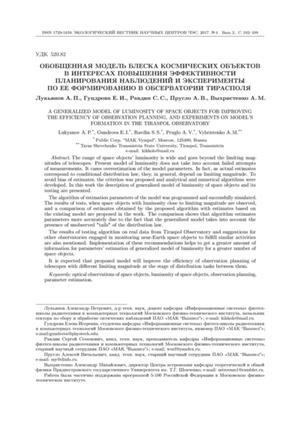Обобщенная модель блеска космических объектов в интересах повышения эффективности планирования наблюдений и эксперименты по ее формированию в обсерватории Тирасполя
УДК
520.82EDN
YMTQSFАннотация
Для повышения результативности планирования оптических наблюдений предложена обобщенная модель для оценки блеска космических объектов, учитывающая наличие ненаблюдаемых "хвостов" закона распределения. Разработан и протестирован алгоритм оценки параметров предложенной модели блеска. Представлены некоторые результаты ее применения к реальным данным наблюдений в обсерватории Тирасполя.
Ключевые слова:
оптические наблюдения космических объектов, блеск космических объектов, планирование наблюдений, оценка параметровИнформация о финансировании
Работа была частично поддержана программой 5-100 Российской Федерации в Московском физико-техническом институте.
Библиографические ссылки
- Лукьянов А.П., Лагуткин В.Н., Мальцев А.В., Колесса А.Е., Ким А.К., Равдин С.С., Пругло А.В., Молотов И.Е., Выхристенко А.М., Андрианов Н.Г. Регулярные оптические наблюдения низкоорбитальных спутников в Тирасполе, Кисловодске и Москве в 2012-2013 гг. Первые результаты и перспективы // Экологический вестник научных центров Черноморского экономического сотрудничества. 2013. Т. 3, № 4. С. 101-105. [Luk'yanov A.P., Lagutkin V.N., Mal'tsev A.V., Kolessa A.E., Kim A.K., Ravdin S.S., Pruglo A.V., Molotov I.E., Vykhristenko A.M., Andrianov N.G. Regulyarnye opticheskie nablyudeniya nizkoorbital'nykh sputnikov v Tiraspole, Kislovodske i Moskve v 2012-2013 gg. Pervye rezul'taty i perspektivy [Regular optical observations of low orbiting satellites in Tiraspol, Kislovodsk and Moscow in 2012-2013. First results and prospects]. Ekologicheskiy vestnik nauchnykh tsentrov Chernomorskogo ekonomicheskogo sotrudnichestva [Ecological bulletin of scientific centers of the Black Sea Economic Cooperation], 2013, vol. 3, no. 4, pp. 101-105. (In Russian)]
- Колесса А.Е., Пругло А.В., Равдин С.С., Ким А.К., Лукьянов А.П. Комплекс алгоритмов автоматического обнаружения космических объектов по оптическим изображениям, оценки угловых координат и параметров орбит // Экологический вестник научных центров Черноморского экономического сотрудничества. 2013. Т. 3, №4. С. 85-90. [Kolessa A.E., Pruglo A.V., Ravdin S.S., Kim A.K., Luk'yanov A.P. Kompleks algoritmov avtomaticheskogo obnaruzheniya kosmicheskikh ob"ektov po opticheskim izobrazheniyam, otsenki uglovykh koordinat i parametrov orbit [A complex of algorithms for automatic detection of space objects by optical images, estimates of angular coordinates and orbit parameters]. Ekologicheskiy vestnik nauchnykh tsentrov Chernomorskogo ekonomicheskogo sotrudnichestva [Ecological bulletin of scientific centers of the Black Sea Economic Cooperation], 2013, vol. 3, no. 4, pp. 85-90. (In Russian)]
- Хуторовский З.Н., Шпитальник М.Ц., Колесса А.Е., Лукьянов А.П. Критерий и анализ эффективности оптических наблюдений космических объектов телескопами ПАО "МАК "Вымпел" // Сборник тр. междунар. конф. "Околоземная астрономия-2015". 2015. С. 250-255. [Khutorovskiy Z.N., Shpital'nik M.Ts., Kolessa A.E., Luk'yanov A.P. Kriteriy i analiz effektivnosti opticheskikh nablyudeniy kosmicheskikh ob"ektov teleskopami PAO "MAK `Vympel'" [Criterion and analysis of the efficiency of optical observations of space objects by telescopes of PAO "MAK `Vympel'{"}]. In: Sbornik tr. mezhdunar. konf. "Okolozemnaya astronomiya-2015" [Proc. Intern. Conf. "Near-Earth Astronomy 2015"], 2015, pp. 250-255. (In Russian)]
- Гилл Ф., Мюррей У., Райт М. Практическая оптимизация / Пер. с англ. М.: Мир, 1985. 509 с. [Gill F., Myurrey U., Rayt M. Prakticheskaya optimizatsiya [Practical optimization]. Moscow, Mir Pub., 1985, 509 p. (In Russian)]
- Линник Ю.В. Метод наименьших квадратов и основы математико-статистической теории обработки наблюдений. М.: Гос. изд-во физ.-мат. лит., 1962. 349 с. [Linnik Yu.V. Metod naimen'shikh kvadratov i osnovy matematiko-statisticheskoy teorii obrabotki nablyudeniy [The method of least squares and the foundations of the mathematical-statistical theory of processing observations]. Moscow, Gos. izd-vo fiz.-mat. literaturi Pub., 1962, 349 p. (In Russian)]
- Fishman G.S. Monte Carlo: Concepts, algorithms, and applications. Springer, 1996. 728 p.
Скачивания

Даты
Поступила в редакцию
Принята к публикации
Публикация
Как цитировать
Лицензия
Copyright (c) 2017 Лукьянов А.П., Гундрова Е.И., Равдин С.С., Пругло А.В., Выхристенко А.М.

Это произведение доступно по лицензии Creative Commons «Attribution» («Атрибуция») 4.0 Всемирная.


